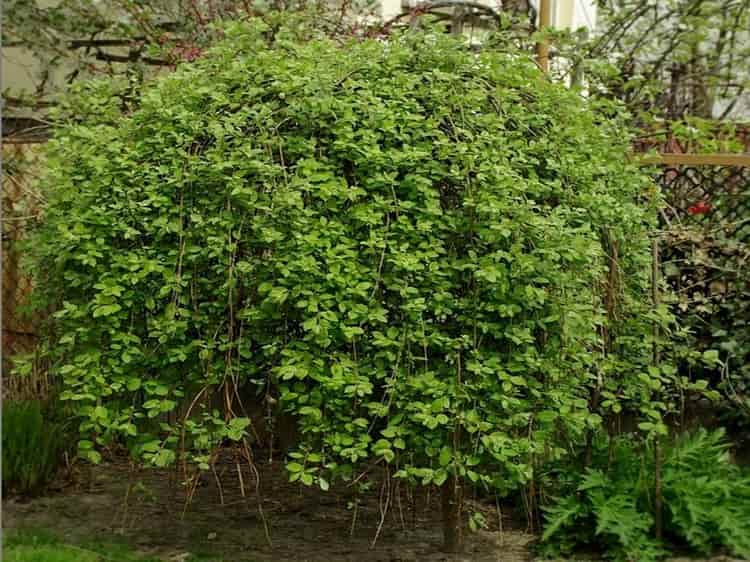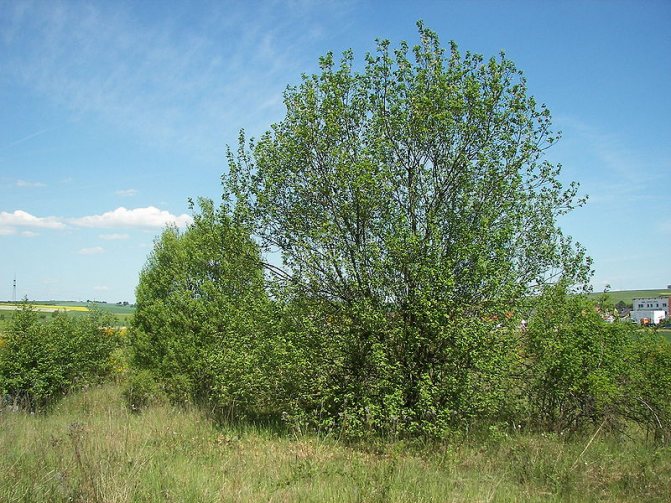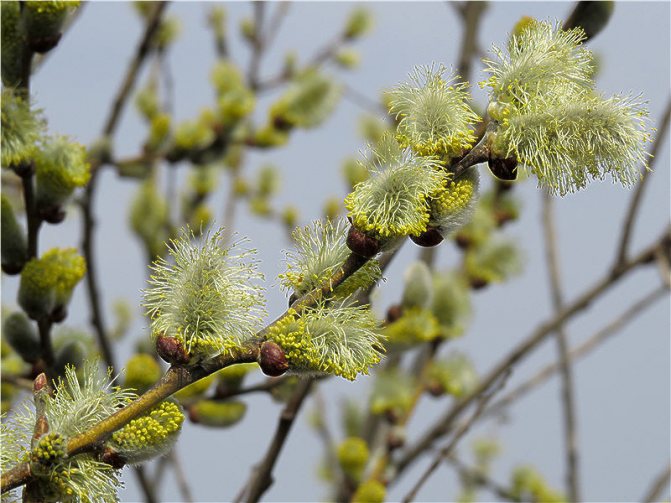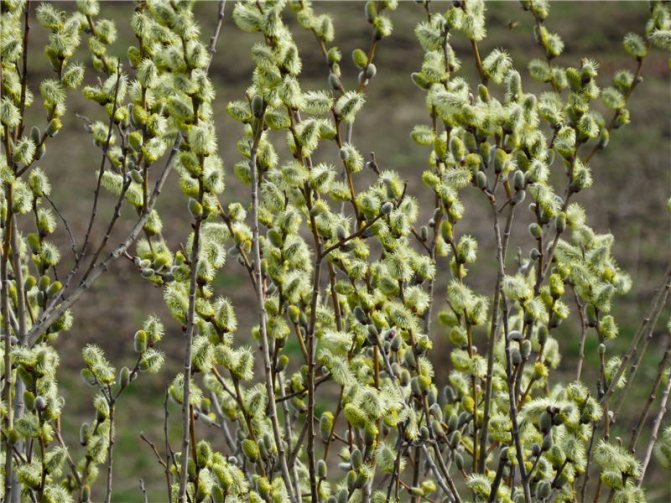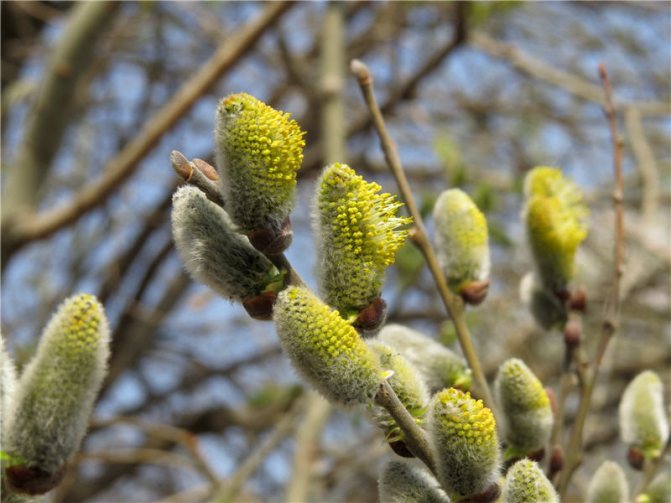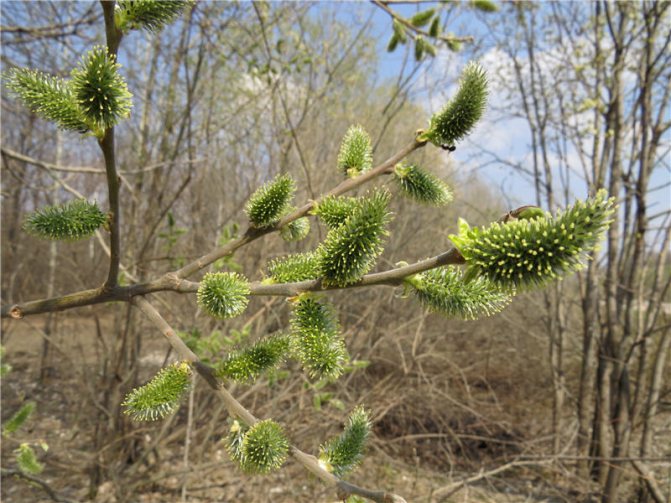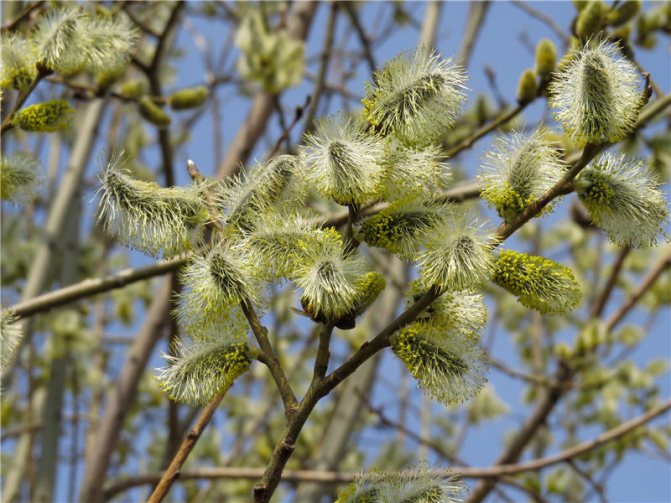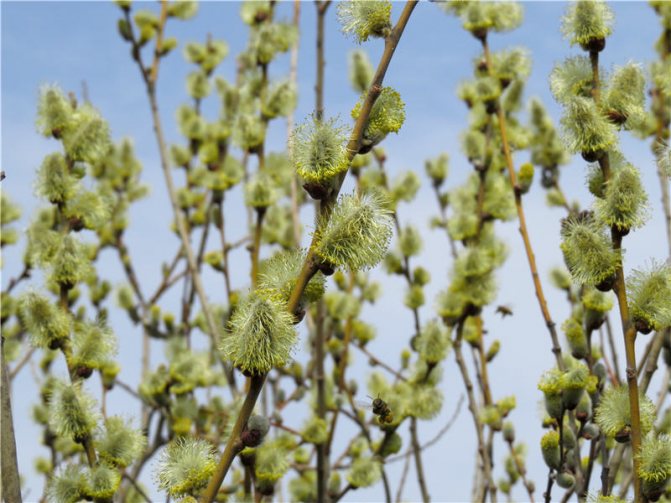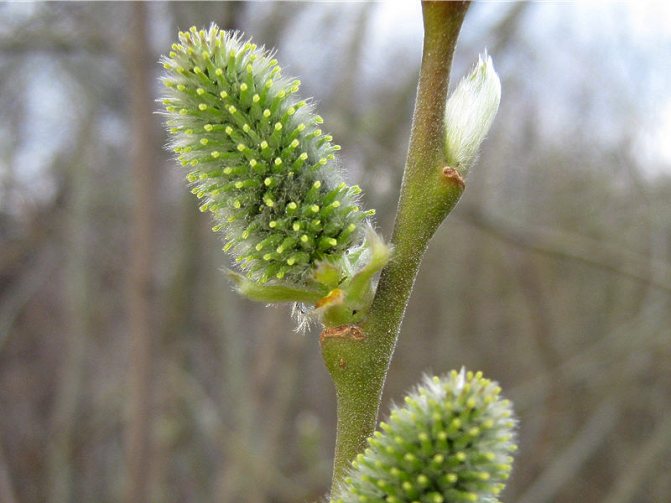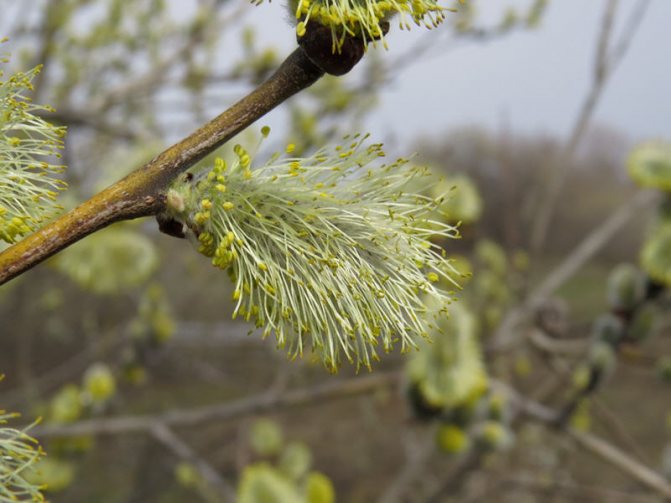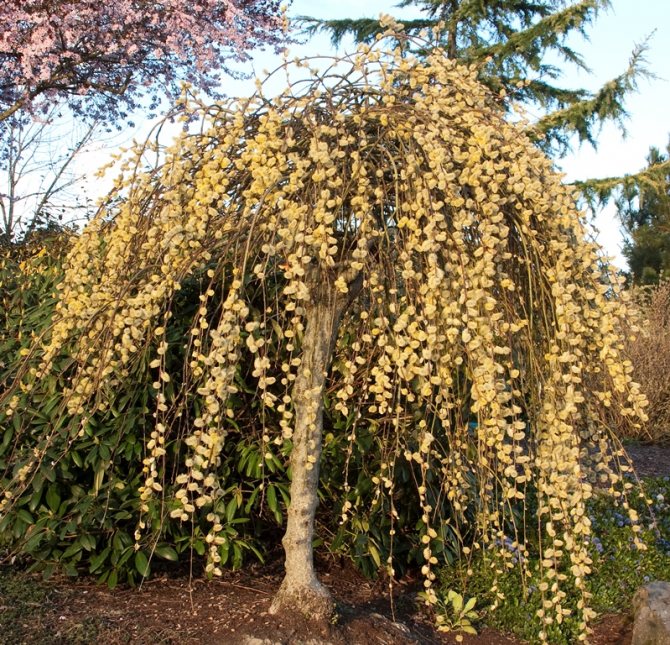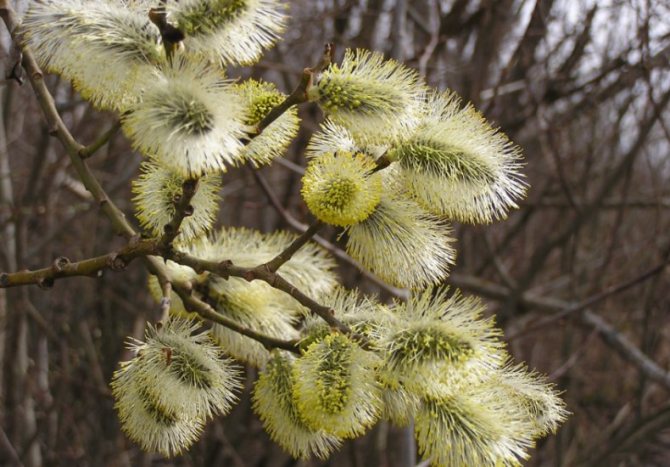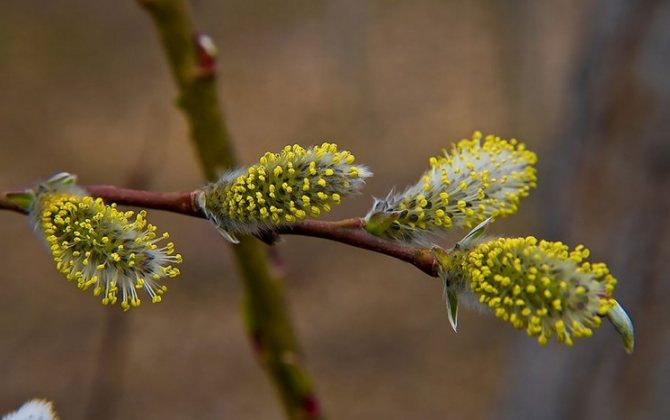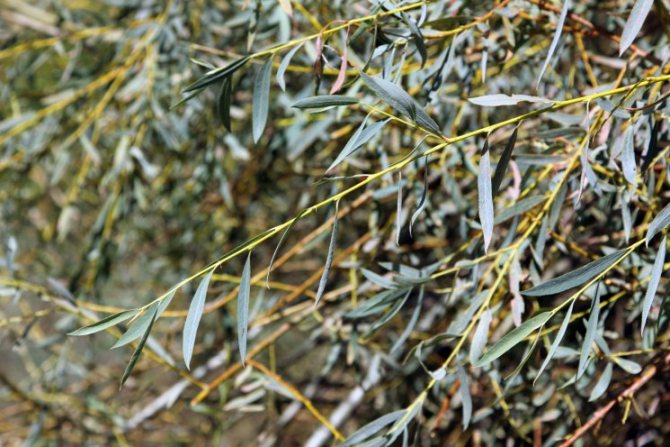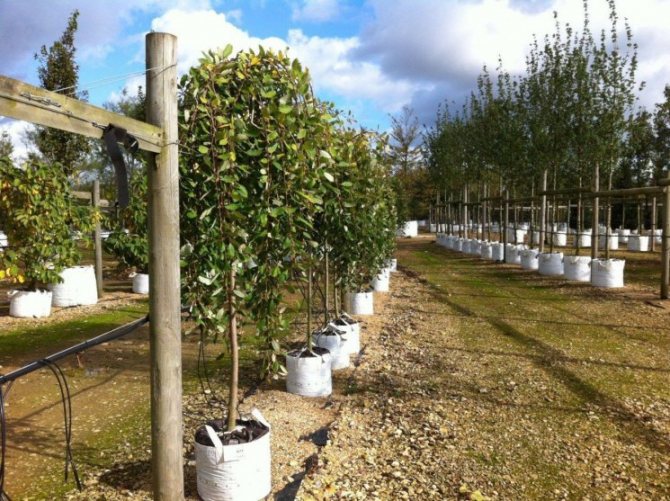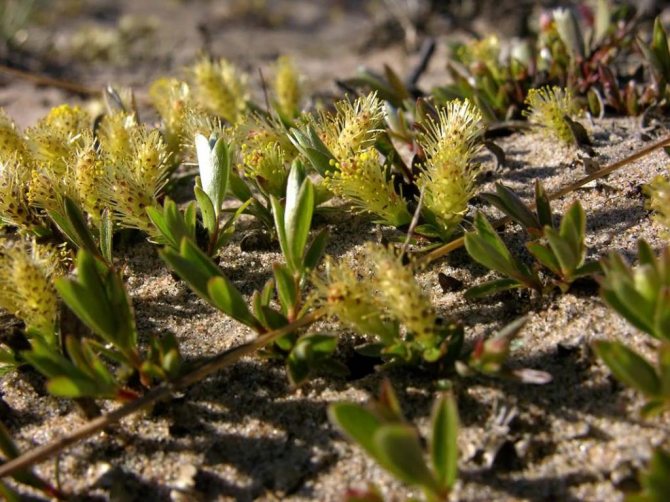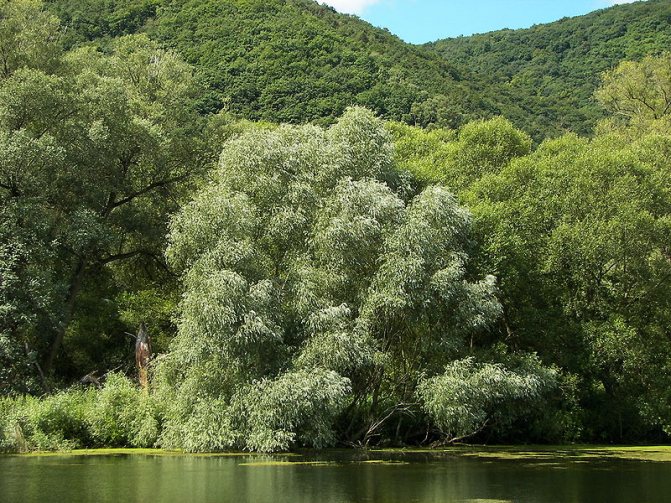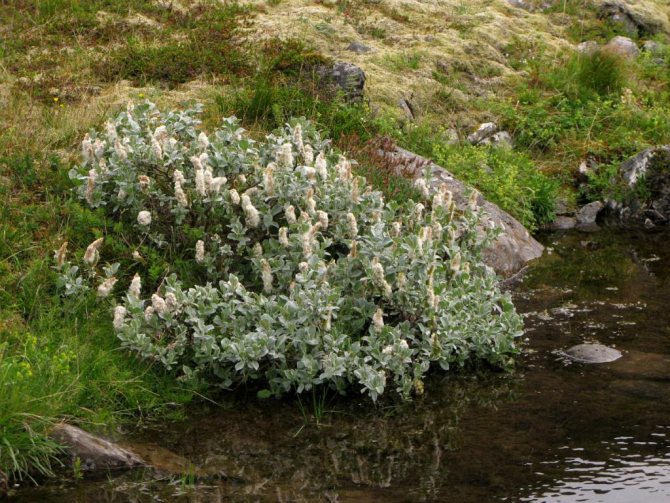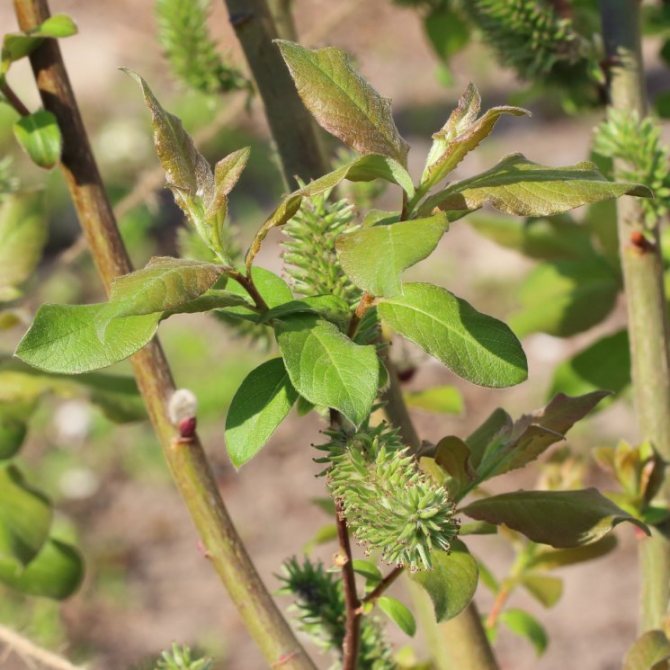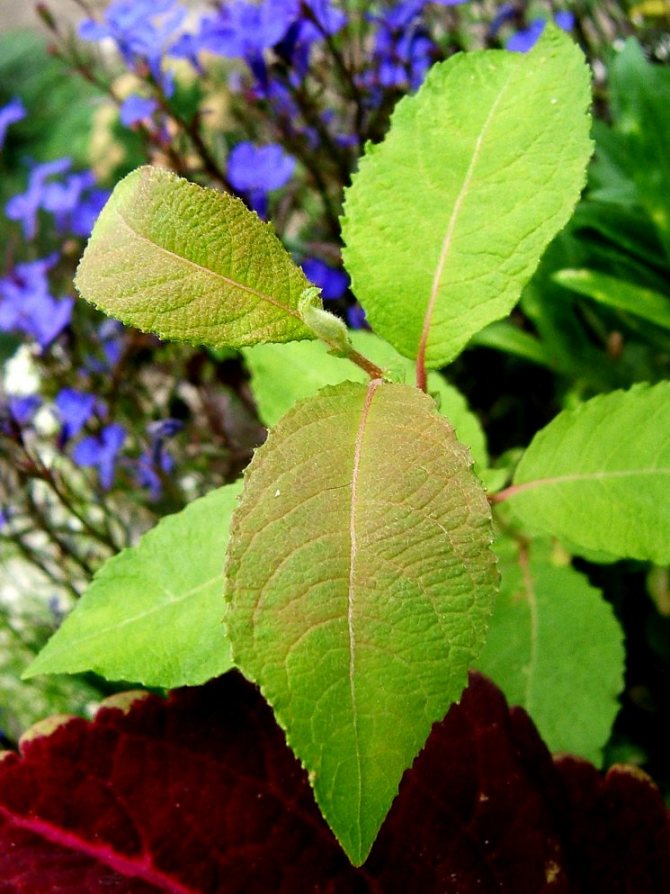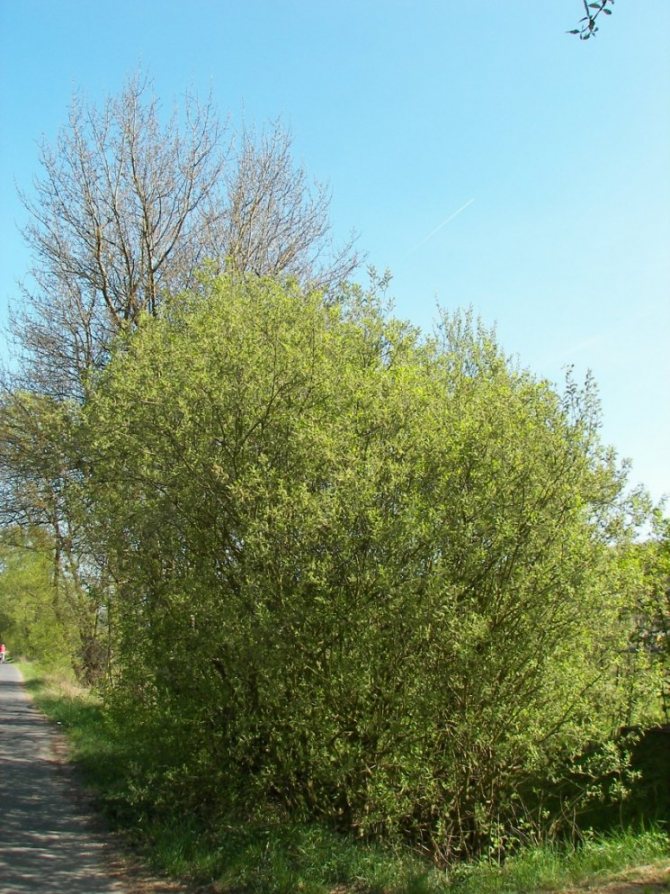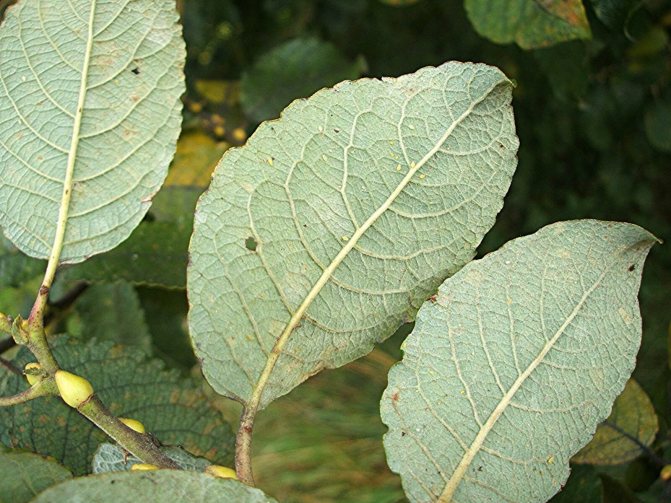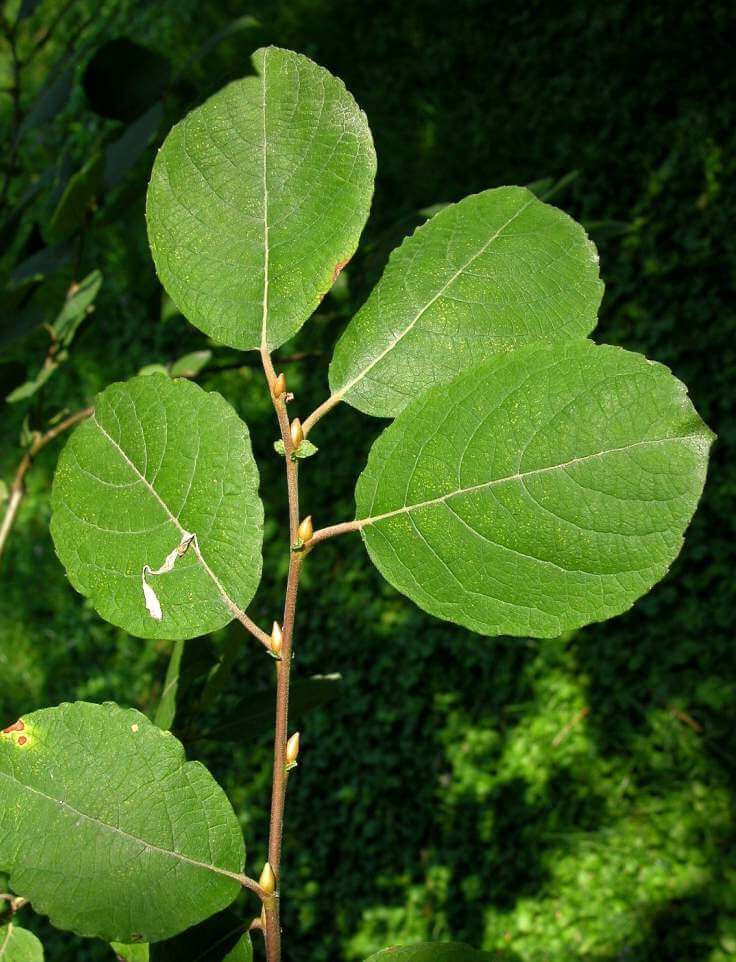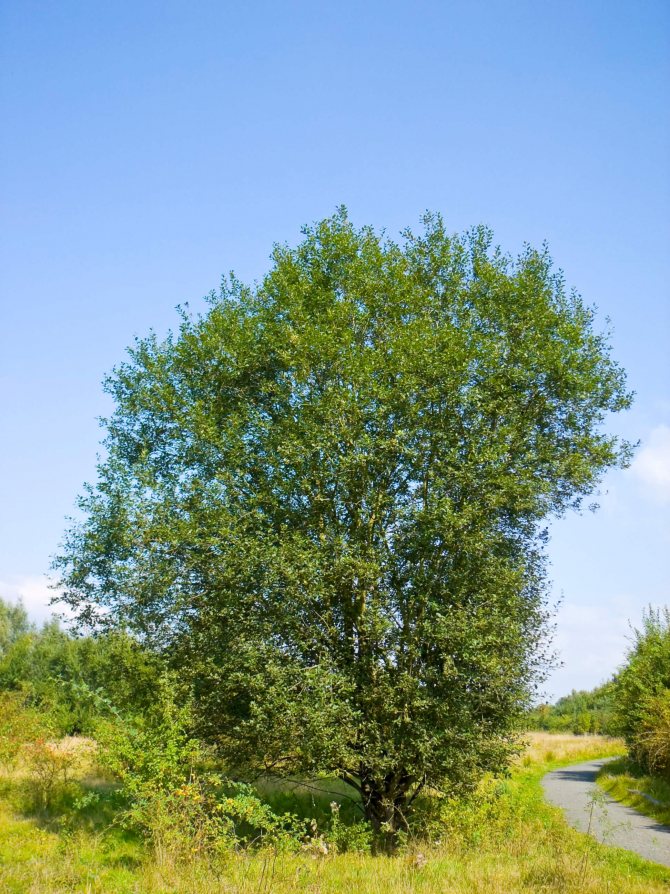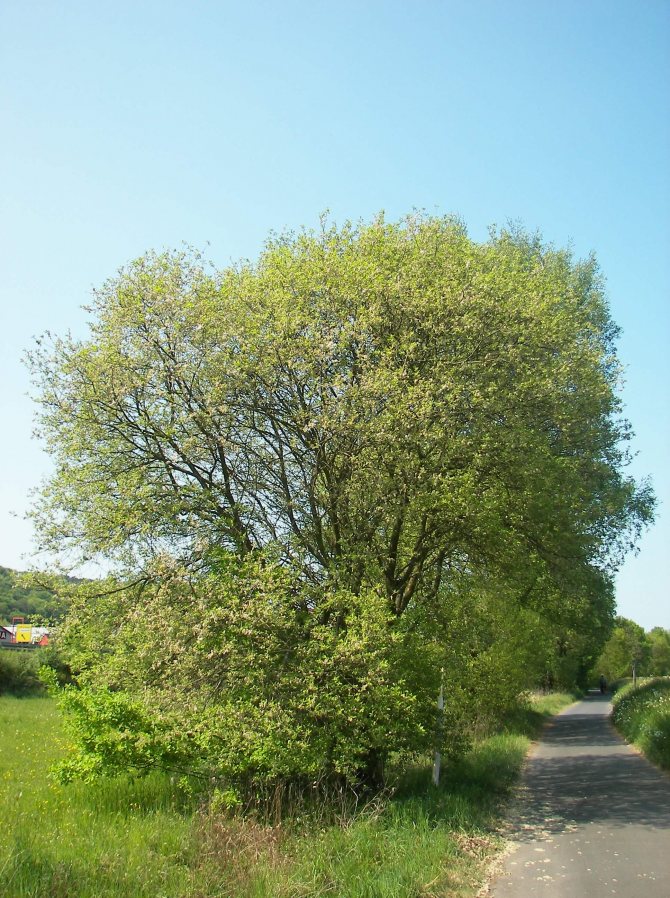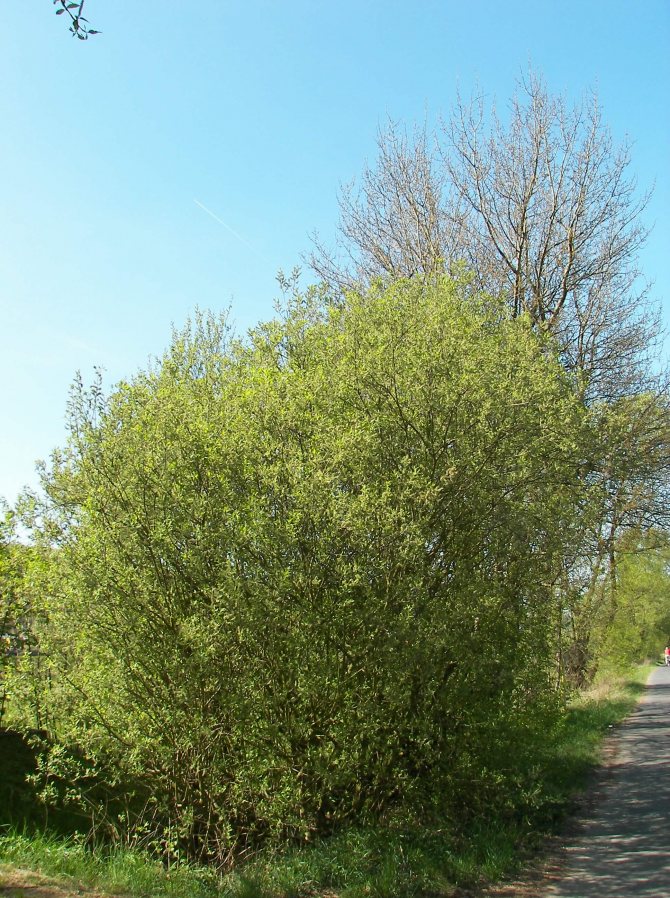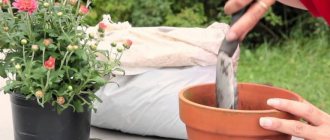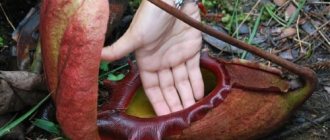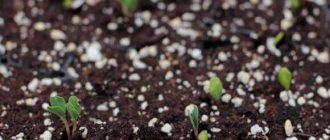Goat willow (lat. Sálix cáprea), bredina, Hulten willow - all names refer to an elegant plant of the Willow family. In its natural habitat, the culture can be found in the form of a tree-like shrub or tree. Goat willow can reach about fifteen meters in length. The crown of the bredina is characterized by a pyramidal structure of a rounded shape. Typical cracks can often be seen on the brown bark. Under the layer of bark, wood is a bright red hue. The length of the rounded leaves is about 10 cm. The width is no more than 5 cm. The inflorescences are represented by massive catkins. After wilting, fruits appear in the form of seed pods. In nature, it is most often found in Western Siberia and the Caucasus.
Natural uniqueness of the tree
The main difference between goat willow is its leaves. Above, the leaf has a smooth surface and a dark green color, and below it is velvety from small hairs and a silvery shade. The goat willow is a small tree or shrub and belongs to the willow family. Young trees have a green-gray bark color, while older trees have a brown surface with small cracks. The shrub has large leaves up to 15 cm in size with round, ovoid and other shapes.
The tree begins to bloom even before the leaves appear. The color of the flowers is yellowish-gray, collected in small brushes, resembling earrings. The fruit of the bush is a capsule in which uneven grayish seeds are formed.
In medicine, goat willow is widely used. The collection of bark, tree shoots is carried out at different periods.
Goat willow is an excellent cure for many diseases. Willow bark must be harvested in early spring (March-April) before the tree is in bloom and buds open. After collecting the bark, the material should be dried out of direct sunlight. Upon final drying, the bark of the plant should crack when bent.
In April, inflorescences are collected from the male forms of the plant and dried in well-ventilated rooms. Flowers contain the same components as the bark, only in smaller quantities, and they are also rich in vitamins, lipids, organic acids.
Babylonian
The "progenitor" of the mourning willow, one of its hybrid forms. In its natural state, it can grow to gigantic sizes, reaching 20 meters in height with a trunk diameter of up to one and a half meters.
Naturally, a cultivated tree will not be allowed to grow to such a size: it does not form such a thick trunk, or chaotically located branches stretching upward. In this respect, the Babylonian willow will be similar with proper care and timely pruning of the mourning willow. It also develops cascading, stepped forms and branches reaching the ground (or water), descending even from the middle tiers.
The color of the bark of the branches is from pale green to purple. The color of the bark of the trunk is light gray. It is moderately resistant to cold weather, therefore it prefers to settle in the valleys of large rivers, where the climate is softened by an abundance of water with an actively evaporating surface, on the shores of large reservoirs or lakes. Although such a willow is actively recovering after frostbite, freezing of thin shoots is not fatal if it is short-lived and not every year. The birthplace of the tree is North China.
For planting, it is better to prefer male specimens: they are easy to recognize by earrings, on which fluff will not form during the flowering period in spring.
During the first 5-6 years, young seedlings need to be sheltered from the cold with agrofibre. Naturally, with free growth, without pruning and cutting, there will not be enough covering material, therefore, during these years, a stem is formed from which skeletal branches will grow. The root system is covered from freezing with a layer of fallen leaves, the insulating effect of which can be enhanced by spreading dense black polyethylene under the trunk in a circle.
The Babylonian willow has the same features as the others: it is able to independently take care of the extraction of water for itself. To this end, the tree has the ability to grow in itself an extremely ramified, powerful root system. The main thing is to plant a seedling near the water's edge.
The Babylonian willow is such a "water crust" that in lowlands with a high level of groundwater, it is even capable of performing the function, if not of a pump for pumping out this water, then at least of a drainage system. A mature, developed tree during the growing season from April to November is capable of pumping out of the ground and evaporating with its foliage up to hundreds of cubic meters of water. It has been repeatedly noted that if a tree growing in a lowland died, or someone inadvertently destroyed it, then a significant swampiness of the site would soon follow.
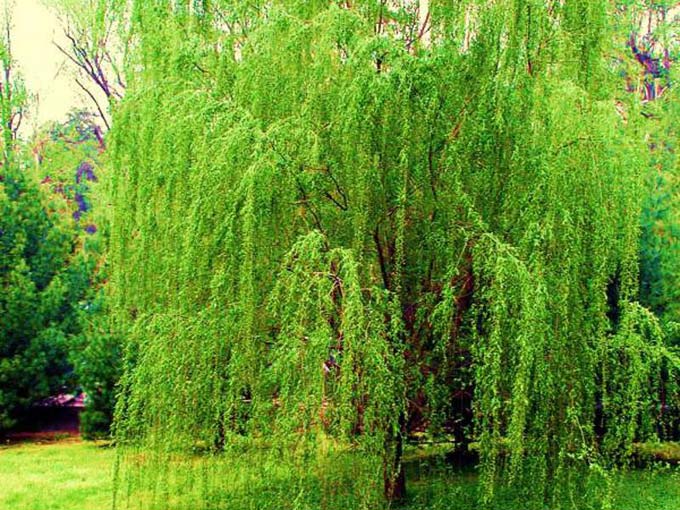
Features of planting and caring for shrubs
Bredina belongs to moisture and light-loving plants. When planting in a summer cottage, you should choose a sunny place. Plant propagation is carried out by grafting and using seeds. The tree is rarely spread by cuttings, because they almost keep the root system out. The shrub is specially pruned after flowering, this is especially important in the first years after planting. Taking good care of the bonsai will ensure that the original shrub grows quickly.
For the correct formation of the crown of the tree, pruning is carried out in such a way that on young shoots the buds rush up and to the sides. With this pruning, young shoots will grow in the shape of an umbrella.
Planting a decorative tree is carried out according to the following rules:
- it is necessary to prepare a pit with a length, width and depth of about half a meter;
- add top dressing by mixing compost, peat and humus;
- add mineral fertilizer and mix;
- plant a tree in the resulting mixture;
- water thoroughly.
If everything is done carefully and correctly, then decorative willows take root easily. Planting trees is carried out in almost any month, with the exception of winter, provided the root system is closed. Otherwise, it is better to plant a tree in early spring or autumn.
Caring for goat willow does not require much effort and special skills. The main thing is to ensure thorough watering for delirium.
With strong drying of the soil and the formation of cracks, it is necessary to loosen the earth to obtain mineral substances, air circulation.
Willow brittle
A small tree, rather even a shrub. Habitat - very wet soil and even slightly flooded areas. At least he likes to settle in floodplains of rivers, where he successfully copes with the functions of drainage plants.
The crown is soft, rounded, like a cloud. By autumn, green foliage acquires a beautiful lemon-yellow color, which looks great against the background of floodplain or swampy meadows.
Pruning is done already in the third year of life, a standard form is preferable, in which the tree will not be allowed to branch. Especially it is necessary to pay attention to cutting off shoots stretching into the crown - they can create an airtight network of branches and foliage, in which pests will very quickly start.
But along with thinning the central part of the array of branches, it is imperative to trace the branches that stretch upward, which are also undesirable.Mainly the lateral part of the crown is left, and in the fall, newly formed buds are additionally cut off on these branches.
Dangerous diseases of the miniature tree
Nevertheless, sometimes the decorative beauty is attacked by the following pests and diseases:
- leaf roll - harms the tree in the caterpillar stage, which can be got rid of by spraying the shoots with chemicals;
- flower fly - often removed after watering the soil with a solution of potassium permanganate;
- powdery mildew is a fungal, rapidly spreading disease; to get rid of it, it is necessary to remove the affected leaves in time;
- black spot occurs when leaves come into contact with water; to avoid disease, the tree should be planted in a windy place.
Diseases and pests
Willow is a hardy and resistant plant. Failure to comply with the basic rules of care causes the formation of white bloom on the foliage. Powdery mildew affects the lower crown of the crop. The fungus can lead to yellowing and premature leaf fall. It is necessary to regularly clean the willow from damaged areas. You can get rid of fungal spores with the help of fungicides.
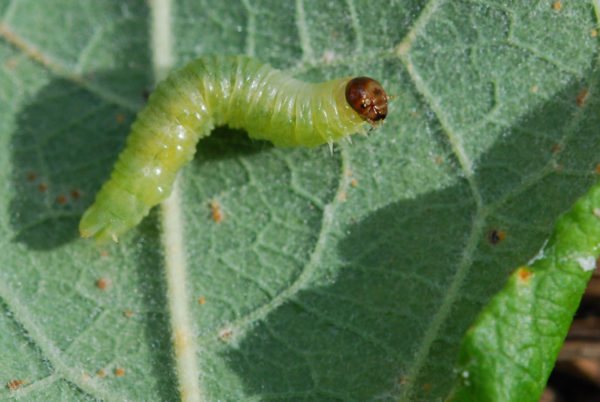

Willow spider sawfly.
Dark points indicate the defeat of the plant by marsupial fungi. Preventing the spread of black spot is easy enough. Leaves should be protected from precipitation. You will need to stop spraying and spraying the liquid. It is necessary to clear the weeds from the trunk circle and remove the debris.
A leafworm or flower fly is capable of destroying a plant. To get rid of pests, you must use a systemic insecticide. Insect larvae can be neutralized by spraying willow with a pink solution of potassium permanganate.
Types of goat willow and their features
Different types of willows. Goat willow: 1a - a branch with leaves; 1b - a branch with male earrings; 1c - female earring; 1d - male flower; 1e - female flower; 1e - an earring with opened fruits; 1g - opened box; 1h - seed. Five-headed willow: 2а - a branch with leaves and male catkins; 2b - a branch with leaves and female earrings; 2c - male flower. Rod-shaped willow: 3а - a branch with leaves. 4 - Willow willow.
Miniature trees have found their place both in urban planting areas and in personal plots. Each species is preferable for a specific area. There are several varieties of goat willow:
- Pendula;
- on the trunk;
- Kilmarnock;
- spherical.
Due to its beauty and frost resistance, the Pendula variety is one of the most popular. The crown of the willow tree is represented by branches falling down, and during flowering, wonderful golden earrings appear, which form before the first leaves appear. The flowers of the shrub attract insects with their high nectar content. The shoots of this variety are brown-red in color, they grow slowly upward and grow rapidly in length. The foliage is dull green, in the shape of an ellipse, covered with villi from the bottom. Willow Pendula is unpretentious and grows in various soils, subject to good watering.
The weeping goat willow lives in the coastal zones of rivers and ponds, in the lowlands of rivers, on well-moistened soils. The owners of summer cottages plant willow on a male-shaped trunk. This variety reaches a height of 2 meters, and sometimes 3, and makes the garden spectacular and bright. The tree consists of a trunk - an even bare trunk with cuttings grafted to it. The branches of the plant hang down to the ground. From such weeping standard willows, you can create arches in the garden. Both owners and neighbors will admire delirium and its beauty.
The next variety, Kilmarnock, will brighten any garden with its hanging branches and eye-catching earring flowers. Like all varieties, the tree is light-requiring, but it can easily tolerate slight darkening.The flowering period of the ornamental shrub lasts about two weeks, the nectar of the willow flowers gives a slight bitter taste to the honey.
The decorative goat spherical willow is characterized by an understated dwarf species. The tree differs from other varieties with a spherical crown with thin shoots hanging to the ground. The leaves of the shrub have a grayish felt cover from the lower part, and a dark green color in the upper part. The flowers of the plant appear long before the formation of foliage and last for about 20 days. Yellow earrings puff and attract insects with their aroma. The spherical willow is resistant to frost and drought, actively grows and adorns park alleys and green areas with its appearance.
Heat-loving willow varieties
Tortuosa
Shrub willow, with strongly twisted branches. The foliage is dark green, and the color of the bark of the branches is golden, which is very well manifested when the branches are twisted. This species is planted in decorative labyrinths of park areas or as green dense fences.
Pruning must be done while maintaining the growth characteristic of this tree (no higher than 2 meters) and in such a way that two adjacent branches retain the ability to twine around one another. That is, observing the pairing of their growth.


Crisp
Dwarf willow, like Tortuosa, grows no higher than 2 meters. The leaves are dark green, shiny and of an unusual shape - in the form of flowers of a rose growing at home, in pots.
Although crispa does not tolerate frost, they cannot kill it - the tree is very viable and quickly recovers. Frost can only negate the pruning made in the previous fall, preventing the formation of a decorative geometric shape of the crown.
Whole-leaved Hakuro-Nishiki
The variety will take root well only in the southern regions of Russia, or in arboretums with protection in the form of frame modules with polycarbonate, which protects the plant from frost. Which is quite possible, since thanks to the process of pruning and shearing, the crown of this large willow bush rarely grows above 2 meters.
It has an unusual color of foliage: it has white-pink-green leaves, with a clear localization of flowers throughout the area. Hanging shoots. The general impression of the bush, especially from a distance, is that it is white-silver, smoky, and only when you come closer, you can see the true picture of the tree's color. It blooms in May, flowers are yellow-green.
When pruning, the emphasis can be placed on any part of the plant: if you cut off the upper shoots, we get a sprawling bush with a predominance of width over height.
The whitish color of the crown makes it possible to combine the Hakuro-Nishiki willow with varieties of plants that have a dark green color. Such as garden or wild honeysuckle.
The use of decorative wood in medicine
A decoction of willow bark reduces the risk of heart attack and stroke.
The bark of bredina contains many tannins, alkaloids, flavonoids. Such substances can also be found in willow foliage. When applied externally, infusions are great for treating wounds, in the treatment of dermatitis.
A decoction from the bark of a tree is used to treat rheumatic diseases, fever. The beneficial components of the plant cope well with headaches and neuralgic problems. It is good to use the infusion for bleeding, because willow has a hemostatic effect. A powder is made from the bark of a plant and used as a powder for the treatment of ulcers, boils.
For people with problems with the normalization of sweat glands, experts recommend taking infusions of the plant inside or making lotions in places of increased sweating.
Less often, decoctions of delirium are used for colds, flu for a general strengthening effect, which contributes to a quick recovery. Having a sedative effect, goat willow has a good effect on the cardiovascular system, treats tachycardia. Natural medicine helps a person to treat obesity. The valuable substances of goat willow help maintain weight and improve overall health.
Goat willow is good for constipation.
For the prevention of many diseases, it is recommended to use tea or kvass from delirium. This procedure must be carried out within a month, twice a year. Wellness courses help reduce the risk of heart attack and stroke. Tea made from the bark of a tree of beautiful color By drinking the drink, you can enjoy not only a pleasant taste, but also get great benefits for the body. But healing tea is contraindicated for people suffering from constipation. In such cases, to saturate the body with valuable substances, it is possible to make medicinal kvass, which has a positive effect on the entire body, helps to thin the blood and normalize the functioning of the gastrointestinal tract.
The power of the goat willow is extraordinary! It is also useful for males to use delirium to improve potency. The components of the plant will help to cure prostatitis with antibacterial properties, and will also have a beneficial effect on blood circulation in the genital area.
British researchers have found that goat willow is capable of curing deadly diseases. The bark of the ornamental tree contains salicylic acid, which has a powerful effect in the fight against cancer. But decoctions of delirium also have contraindications:
- gastritis with high acidity;
- low blood clotting;
- individual intolerance to substances;
- pregnancy;
- childhood.
Bredina is a real find for decorating a garden!
With regular pruning of the tree, you can create an original crown or hedge anywhere.
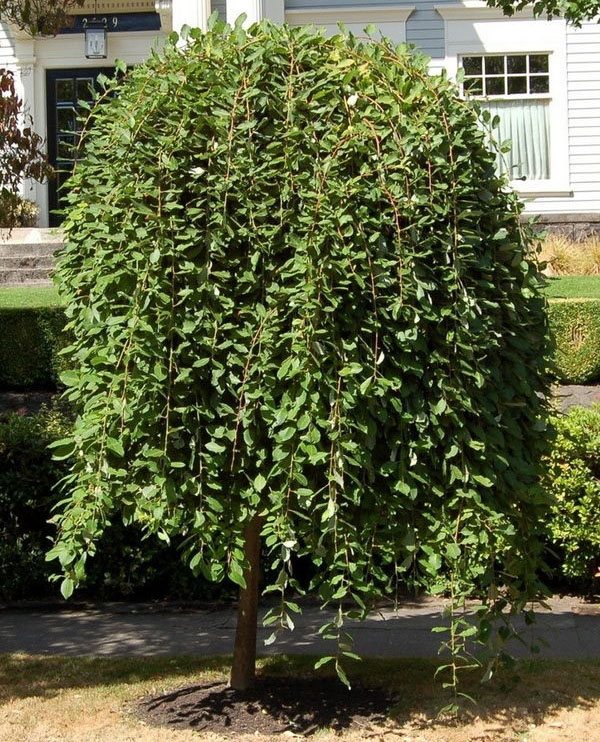

Goat willow, otherwise botanists call it Bredina (Selix carrea), and in the common people simply Rakita, a plant belonging to the Willow family. Europe is considered its homeland, but it grows successfully in Western Asia, the Caucasus and Central Asia. The average life expectancy is 150 years. During this time, the plant height can reach 10 m and 0.75 m in trunk diameter.
Many gardeners are wondering, is goat willow a tree or a shrub? Everyone calls it differently, but in the general classification it is a deciduous tree, sometimes a treelike shrub. Based on the name, we can conclude that sheep and goats like to feast on the plant.
Reproduction and cultivation of a tree
Propagated by seeds, grafting and cuttings. Seeds must be used after 10 days after ripening, otherwise germination is lost. Flowering begins in April with golden catkins about 10 cm long, it lasts about 2 weeks. The fruit is formed in May. It has the shape of a box measuring 8 cm, which contains up to 20 seeds with fluffy growths.
It is easier to root a tree by cuttings. To do this, cut branches at least 10 cm long should be placed in a bucket for several days. Good drainage must be done in the hole, compost, place a stalk, bury and provide abundant watering.
The crown should be formed immediately by cutting off the lower branches, the growth bud should always be directed outward.
Not every gardener can graft on a stem. This is a rather complicated process that requires some knowledge and skill. Goat willow on a trunk does not take root in all varieties. For this, Pendula is best suited. You can also use your own trunk as a trunk. Subsequently you need to monitor the kidney very closelyso that it does not appear below the vaccination site. If this happens, then the kidney must be removed.
The best option would be to purchase a ready-made seedling in the nursery. When buying, you need to carefully check the tree so that it is healthy. The bark should be intact without cracks, there should be no dead scales.
Soil preparation and watering
Bredina is not pretentious to the soil, it will take root well in almost any conditions. But it will feel best on loamy soil, which is dense and retains moisture well.In the spring, for planting, you will need a hole 40 cm deep and 50 cm wide (so that the entire root system fits). At the bottom of the hole, you need to make good drainage, then fill 1/3 of the earth or better with such a mixture; in a 1: 1 ratio, combine compost, humus and peat, you can also add a little sand. For growth, feed with nitrogen fertilizer, then place the seedling in the center and bury it.
After watering abundantly, a young tree will need about 25 liters of water per week. To make the moisture evaporate less, it is recommended to make a layer of mulch near the trunk. To do this, you can use the following materials: sawdust, pebbles, expanded clay, peat, dried grass, paper. And also regular hilling will be required, which will oxygenate the plant and the soil will not crack.
Shrub pruning
It is the correct haircut that gives the goat willow a decorative weeping or spherical appearance. Crown formation occurs during the first few years of the tree's life. Shoots are cut short, branches about 15 cm long remain. It is necessary to make sure that the bud of the post looks up. Here basic rules for pruning:
- Performed in June, after flowering. If produced in the fall, the plant may not bloom the next year.
- It is better for novice gardeners to monitor the growth of branches throughout the summer, periodically correcting the crown. This method is also necessary for a young tree.
- In an adult tree, pruning is done 2/3 of the branch length.
Diseases and their treatment
The plant is resistant to many diseases, but sometimes they cannot be avoided. Powdery mildew (white bloom) or black spots may appear on the leaves - this is a fungal infection and is destroyed by special antifungal drugs, fungicides. Affected leaves should be removed, and spray the bush with a fungicide, for example "Topaz". From black spots, you need to ensure that during watering, water falls on the foliage as little as possible, burn bad leaves and treat the surviving ones with such preparations as "Skor" or "Pure Blossom BAU".
Of the pests of weeping willow, the flower fly and willow leafworm are bothered. Watering with a weak solution of potassium permanganate will help get rid of the parasites of the fly, which will kill the larvae, or you can use insecticides. Spraying with "Fitoverm" or another similar preparation will neutralize a butterfly, a willow leafworm.
Short description


The plant loves light, however, it has shade-tolerant qualities. Favorite growing areas: fertile, rich, sandy or gravelly soils. At the same time, they should not be highly moistened - this can destroy the tree. How is the conclusion? watering should be moderate. There is a bush along roads, houses, on the burrows of the forest, clearings. For planting, formed seedlings are used. If you need to propagate, then cuttings, seeds, or a method of grafting are suitable for this.
The characteristic features of the plant are:
Photo gallery
Beauty and form
Goat willow is very common in landscape design. And all thanks to its beauty and shape. Moreover, the appearance of the plant is highly dependent on the soil in which it grows, and the illumination.
Most often, rakita is planted in the improvement of private houses and estates. At first glance, the willow looks unprepossessing, but thanks to its weeping forms, grafted onto the stem, it acquires a very attractive appearance.
Willow looks great in rocky gardens, as well as on the edge of water bodies. It is worth appreciating another advantage of the plant - the ability to cement the soil with roots, so it is not surprising that it is often planted on slopes.
Distribution and ecology [edit | edit code]
The range of the species includes Europe, except for the tundra and the alpine belt, the Caucasus, Western and Central Asia [6]. Often forms hybrids with other species [7]: 155.
In Russia, goat willow is widespread in almost the entire European part, in the Caucasus, in Siberia, in the Far East [8].
It grows in damp forests of various compositions (less often in conifers [7]: 155), mainly on rich soils, clearings, forest edges, along roads, often near dwellings. Avoids highly moist and, especially, waterlogged soils. In the mountains it reaches the upper border of the forest (in the Caucasus - up to 2700 m) [8].
Propagated by seeds. Cuttings, unlike other species of willow, root poorly. When felling under natural conditions, it multiplies by shoots [7]: 155.
Various fungi grow on living and dead wood of willow, for example, living wood lives Phytophthora ramorum [en]
[9] .
Conservation status [edit | edit code]
Varieties
Most often, gardeners pay attention to willow varieties such as "Silberglanz", which has a height of up to 8 m and a spreading crown, "Pendula", the main advantage of which is a weeping crown and a standard shape, and "Mas", which has a wide spreading crown and reaches a height of up to 10 m.
Goat willow Pendula
This is a deciduous tree, reaching a height and length of up to 2-3 m. As a rule, it lives no more than 30 years on soils of any moisture. A kind of shade-tolerant and photophilous. For normal growth, abundant watering is necessary. But in order to avoid overflow, a rather high drainage layer should be laid. The plant is frost-resistant, but it is recommended to cover the stem for the winter.
The dignity of the plant, we repeat, is a tent-shaped weeping crown. Goat willow looks great on a trunk. Of the many varieties, pendula can be identified by its dark green oblong-elliptical foliage up to 8-10 cm long. In autumn, the color turns yellow.
In April-May, flowering occurs (lasting 15 days) with the release of flat golden-yellow earrings. In the future, the fruit is formed in the form of a box.
In landscape design, pendula is planted both as a single tree and in decorative groups. Looks great in rock gardens and near water bodies. It goes well with dwarf coniferous trees, juveniles, moisture-loving plants and ground covers. As for reproduction, the procedure is performed by inoculation on a stem.
The most difficult thing to care for is pruning the Pendula goat willow. If the crown is not formed correctly during the first year, the branches will settle to the ground and the decorative value will be lost.
In young animals, all branches are pruned, leaving a length of only 15 cm. In this case, a bud should remain, looking to the side or up. But not inside the crown. With such a haircut, they achieve the formation of a shape similar to an open umbrella.
If the plant is adult, then pruning is carried out after flowering, shortening the branches by 2/3 of the entire length. This achieves dense branching of the crown.
Goat willow Kilmarnock
This variety is distinguished by its diminutiveness (maximum 1.5 m in height). The standard tree resembles an open umbrella with branches reaching the ground. The plant is frost and wind resistant, photophilous. It has no soil requirements, grows well on low-lime, loamy soils. The only drawback is sensitivity to moisture, so you need to be careful with watering.
You can identify the variety by foliage. It is green, oblong-elliptical, slightly wrinkled, yellowing in autumn.
In April, bloom begins with the release of numerous earrings with silvery and fragrant flowers.
The choice of planting material
Arriving at the nursery, you should know exactly what to look for in order to buy a tree such as the Pendula goat willow. Planting and care will depend directly on the quality of the seedlings. We invite you to explore our following tips:
Advice 1. Specify how the scion was obtained. Today there are two main methods:
- pruning;
- graft.
Based on this information, you can schedule further tree care.
Advice 2. If the second method was used, then carefully examine the vaccination site. The presence of dead scales on the bark is not allowed. The trunk should be straight and strong.
Tip 3. Buy only the goat willow that has increased winter hardiness.
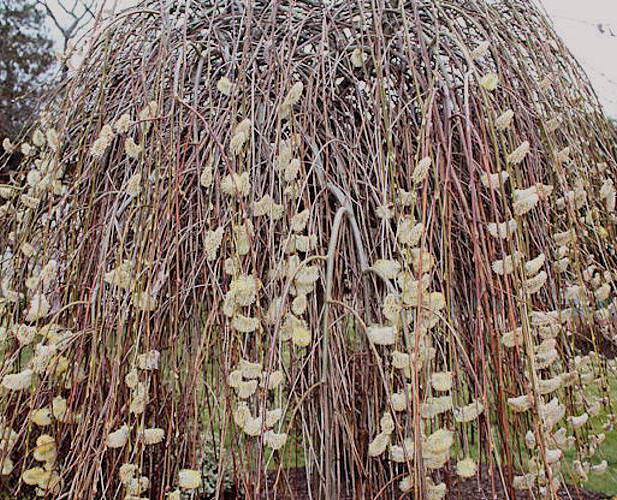

Here are some simple guidelines to help you buy the right and healthy plant, such as the goat's willow Pendula. Planting and grooming are the next important steps.
Goat willow: planting and care
Planting is carried out with the onset of spring. Cuttings are placed in water in advance and wait for the roots to appear. After they should be transplanted into open ground, having previously dug a shallow hole. The extracted soil is mixed with compost, and after planting, the cuttings are poured into a hole and the soil is slightly crushed. After that, you should water the plant well with water. Subsequently, watering is performed 2-3 times / week. For adult specimens, regular watering is not required. If the weather is dry and hot in summer, the seedlings should be watered more often.
As for feeding, in the spring-autumn period it is carried out twice with complex means. In autumn, give preference to sulfuric potassium or superphosphate. In the presence of a large number of weeds around the tree, mulching is carried out with sawdust, peat, expanded clay, paper, crushed pebbles.
In case of rapid drying of the earth near the goat willow, loosening should be carried out, and if cracks have gone, then first the ground is watered and then loosened.
Do not forget about timely and regular cutting of trees.
Proper planting, watering control, and willow pruning will help you form a beautiful plant that will add grace to your home's landscaping.
Meet the goat willow - video
Plant nursery "Earth Sign"
Landscaping of the site is a real art, in which a whole group of specialists is involved
... Landscaping is individual, because you are unlikely to find two identical plots: each house with its surrounding plot and landscape is unique. Therefore, designers and planners create a landscape design suitable only for you and where all your dreams are realized. The landscape design is entirely up to your imagination. For example, you need to decorate your terrace beautifully for a pleasant pastime. Or maybe you are dreaming of a small pond, where a cascade with murmuring water will be arranged. If the project provides for a pool, then a changing cabin is needed, and the ground around the entire perimeter must be covered with safe materials.
Having equipped a fountain, you can listen to how falling water sounds
... Someone does not need the presence of reservoirs on a personal plot, then a landscape design specialist can realize the appearance of the presence of water with the help of a "dry" stream. The imagination of our landscape designers is limitless, and the photo gallery of our completed projects will help you in determining what a summer cottage should be like. Our company employs creative individuals who are experienced and highly qualified specialists who are ready to fill your garden with life, which will bring the joy of communicating with it for many years. Our landscape design studio strives to preserve and improve the natural nature that has developed on the site. In this regard, each tree, shrub or part of the relief, at your request, will become integral organic elements of the new garden design. Our specialists treat their work with love and will be happy to provide any help!
We are engaged in landscaping
personal plots, summer cottages, suburban and urban areas. Our task is
an integrated approach to landscaping
... We are ready not only to hand over beautiful and adapted plants to you, but also to deliver and plant them.
Our plant nursery employs only competent and qualified specialists in various fields.Each of us has unique knowledge of planting and transplanting plants, pruning trees and shrubs, we will tell you how to properly care for the garden and give you recommendations for landscape design.
Planting / leaving:
It is better to buy seedlings of goat willow Kilmarnock grown in Ukraine with a large lump in sacking, so the plant after planting is guaranteed to take root. All plants purchased from the PROXIMA nursery are provided with prolonged fertilizers with the latest formulas of the best European manufacturers and can be sold in your garden center without additional fertilizing for a whole year. But the biggest advantage of buying potted plants is that they can be planted, without buying additional fertilizers, from March to December - even on the hottest days of summer.
Willow Kilmarnock requires minimal pruning. Remove any broken, diseased, or unnecessary branches in late fall or winter. It also requires regular removal of lawn grass from the trunk circle, mulching with a thickness of at least 7 cm.Feed with granular long-acting complex fertilizer in early spring. We fertilize as usual with balanced NPK + Me in spring - nitrogen, in summer - phosphorus, August - September - potash. Do not forget about improving the soil structure with organic matter (humus, compost), and regular foliar treatments with mineral and organic fertilizers with an adhesive.
Pests and diseases:
The goat willow Kilmarnock is resistant to pests and diseases. An untreated plant can be affected by powdery mildew, green leafworm, fruit cap moth, and necrosis of branches and trunks. To protect the plant from diseases and fungal infections, it is necessary to treat plants with fungicides (Skor, Switch, Maxim, Ordan, Horus, Quadris, Radomil Gold, etc.). Certainly, it is better to have a “diagnosis” made by a specialist. But, as a rule, a modern gardener using the Internet can independently identify the enemy and choose the right methods and means of plant protection. To protect the tree from the pest, preventive spraying with insecticides (Aktara, Engio, Aktellik) is carried out in the spring. Compared to the gluttonous larva of the May beetle, other pests on a well-groomed plant are rare. Over the past 10 years, Khrushchev, especially on humus-rich, weed-free soils, has become the most dangerous pest of garden plants in Ukraine. One beetle larva can nibble the root system of a young 10-30 cm seedling in 1 day, completely destroying it. Since mid-April, having seen the first flying beetle, we URGENTLY treat the crown with any of the numerous preparations based on imidacloprid, for example Prestige (Bayer), Antichrushch, while part of the solution must necessarily fall on the trunk (10 cm above the ground) and the root collar and not spill to the side ... We repeat such treatments every 40-50 days of the growing season. We pour it into the soil according to the instructions, Aktara is also effective (active ingredient - 240 g / l thiamethoxam; 250 g / kg thiamethoxam). Processing along the crown and pouring along the root collar into the soil from the end of April to September 1 time in 40-60 days.
Buy
Kilmarnock's willow goatKiev at low prices can be in the PROXIMA plant nursery.
Well-lit and wind-protected locations are recommended. Prefers moist soils, but grows in moderately dry and even dry sandy soils. High lime content in the soil should be avoided. Before planting, a shallow hole is dug, the earth is mixed with compost, a layer of crushed stone and gravel is poured into the hole. After planting, the soil is tamped and watered abundantly with water. Young plants are watered 2 - 3 times a week.
Plant care
Basic tree care includes:
- Watering. In the first year of life, this willow variety needs abundant moisture. A weeping beauty should consume about 50 liters of water in two weeks. If the summer is too dry, then this volume goes away in a shorter period.In the second, third and subsequent years, one irrigation is sufficient, which can be carried out every week.
- Fertilizer. For the entire period from early spring to autumn, you need to feed the willow two or three times. Complex mineral fertilizers are suitable for this. In September, the tree is fed with superphosphate or sulfuric potassium. If a dark bloom appears on the leaves, then copper oxychloride is used for treatment.
- Mulching. It helps to retain moisture and stop weeds from growing. Peat, paper, sawdust, expanded clay or pebbles are ideal for this. All this material is crushed and scattered under the tree on top of the soil.
- Loosening. If the ground under the plant is too dry and cracks have formed, they must be removed. To do this, loosen the soil a day after watering.
- Preparing for winter. This step in care is also significant. In order for the plant to endure our harsh winter well, the trunk is wrapped in a covering material. This procedure is used for trees under three years old.
We looked at how to properly care for a plant such as Pendula goat willow. Pruning is another main type of maintenance that we will pay special attention to.
Pruning Goat willow "Kilmarnock"
Special pruning is required, especially in the early years, to form the crown. Pruning is carried out after flowering, in late spring - early summer (in June). For the correct formation of the crown, it is necessary to cut off all young shoots of the first year shortly (up to 15 - 20 cm), so that at the end of the shoot there are buds directed upward and to the side, then the crown will grow in the form of an umbrella. Another way of pruning: during the summer, pinch the apical buds of young shoots, as soon as they reach a size of 15 - 20 cm. This encourages the lateral shoots to grow and the crown is dense. It is recommended to remove the undergrowth that forms under the inoculation site.
Purple Nana
The smallest variety of purple willows, at a height of less than 1.6 meters. Flowers during flowering in May are light green, oblong in shape. The branches are red-brown, the foliage is gray-green, in the fall it turns yellow-green, and falls off in this form.
The crown in its natural state takes a semicircular shape, but with a very uneven distribution around the circumference. Therefore, the task of those who take up cutting the tree will be to give the crown a mushroom shape.
In the radial branches of the purple Nana willow, it is also advisable to cut off the extra buds that can form lateral extra shoots penetrating the crown in all directions - only radial ones should remain!
How to care
It is an unpretentious plant to care for and does not require much attention. When planting, it should be borne in mind that this tree is moisture-loving and requires a special approach to watering. Young, only planted plants must be watered and sprayed.... An adult plant can be watered much less frequently, but it should be watered anyway. Spraying is best done early in the morning.
Still, silty or sandy soil is not suitable for it. The ground should be moist and breathable. The earth around the tree needs to be periodically loosened... Feels good in well-lit places of partial shade, but in a very dark place it will not grow.
In spring and autumn, the plant is fed with complex fertilizers... In the autumn, superphosphate and potassium sulfate are used. Mulching with sawdust or peat will reduce the amount of weeds near the tree.
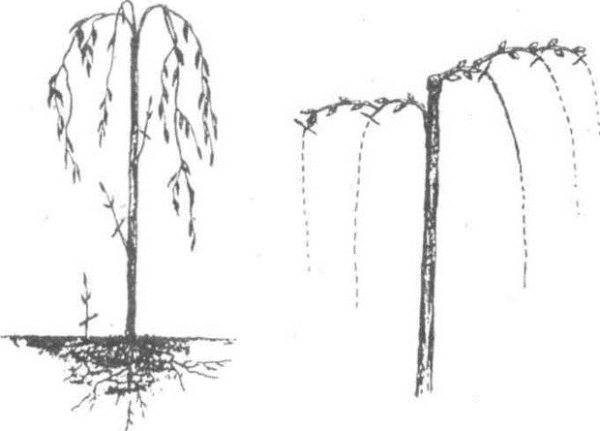

As a rule, Goat willow pruning is carried out at a height of 30-60 cm
Susceptible to powdery mildew infection. If the tree is sick, then this will manifest itself as a white bloom, which will appear on the leaves. Damaged leaves must be removed so that the infection does not spread throughout the foliage.... The goat willow can be attacked by a flower fly. Fight insects with insecticides.
Growing conditions
to the soil: not demanding
to temperature: frost-resistant
Homeland: Europe, Central Asia.
White willow ‘Pendula’ ‘Tristis’ goat ‘Pendula’ brittle purple ‘Nana’ ‘Pendula’
Most willows are light-requiring and grow better in open places, the goat willow is shade-tolerant and grows normally in partial shade.
Soil mixture: Soils can be different: sandy, swampy, not very fertile, gravelly.
Drainage is required on heavy clays, a layer of 20-30 cm of sand or gravel.
The optimum acidity of the soil is pH 5 to 7.5.
Top dressing: With weak growth, nitroammofoska (60-80 g) is applied in the spring.
Watering: In hot weather, it is recommended to water and spray willows if they do not grow near bodies of water.
Young plants in dry seasons require more frequent and abundant watering.
Loosening: Only young plantings, in spring, to the depth of a shovel bayonet.
Mulching: It is advisable to mulch with peat in a layer of 5-7 cm.
Pruning: Trimming dead branches, shaping the crown and trunk, removing very long shoots on the lower part of the trunk, if it is not a weeping form.
Tolerates haircuts well.
Choosing a landing site
When choosing a planting site, keep in mind that the plant is very light-requiring. In addition, it reacts very sensitively to strong drafts. The superficial root system is sensitive to moisture, so a good drainage layer should be laid during planting. In order for the roots to grow faster, a fertile mixture, humus, compost should be added to the planting pit.
Willow is not at all demanding on the soil, but it has been noticed that the most lush specimens grow on fresh and light loam. He loves wet soils, but at the same time he feels good on dry sandy soils. The main thing is that there is no lime admixture in the soil.
Consortium connections
Some Hymenoptera and Diptera are pollinators of goat willow. Bumblebee on inflorescences Goat willow leaves are food for both hymenoptera larvae (Trichiosoma sibiricum) and lepidoptera caterpillars (Acleris cristana, Teleiodes notatella, etc.). Corydalis caterpillar zigzag
The goat willow is a good food for many animals, especially for insects that feed on leaves, buds and young branches, or for insects that develop larvae on the willow, for example, for some species of barbel.
Beetles are often found on goat willow. The willow booger (Lochmaea caprea), the golden flea (Crepidodera aurata) (on those willows that grow near water bodies) and some others feed on leaves. In some species of barbel, larvae develop in wood or under the bark of live goat willow. The larva, having hatched from an egg that was laid by the female in a crack in the bark, bites into the bark, and then into the trunk, where it will feed and develop for a couple of years. The last stage larva makes a cradle in the willow trunk, where it will pupate. Such barbel is, for example, musky barbel, willow fat man.
Description of willow with photo
Fast-growing and easy-to-grow deciduous willows, depending on the growing zone, can take a very different form - from dwarf and creeping shrubs to large majestic trees.


Blooming willow garden
Willow leaves are most often narrow, lanceolate, but can also be elliptical or nearly round, smooth or slightly pubescent. In spring, plants are attracted by decorative fluffy male earring inflorescences, popularly known as "cats".
Some have very large inflorescences, almost 6 cm in length. They can be golden, reddish or silvery, depending on the type of willow. Willow flowers are melliferous. The willow is one of the earliest flowering plants, and its pollen and nectar are the first food for bees after winter.
Due to the ability to form adventitious roots, the plant propagates very easily with the help of cuttings, but the seed material is viable for only a few days, after which the seeds lose their germination.
Economic value and application
Good early honey plant. In addition to an extremely large amount of nectar (under favorable conditions it can produce up to 4 kg or more of honey per colony), bees collect goat pollen, honeydew and glue from willow: 155. Fine-grained goat willow honey has a golden yellow color.
Goat willow is one of the main industrial sources of "willow bark", from which a first-class tanning extract is obtained, suitable for the production and dyeing of the best varieties of leather, including morocco and glove leather (the tannin content in the bark reaches 16.5 and even 21%) ...Black dye is also obtained from the bark.
Durable reddish wood is used for small crafts and "cold" buildings. It can be used to produce cellulose. Young shoots are used in the manufacture of coarse wicker containers: 155.
Young shoots with large leaves, which contain up to 200 mg% of vitamin C, are used as food for sheep and goats, most often in the form of brooms, and also occasionally serve as a surrogate for tea.
In folk medicine, it is used as an astringent, anti-febrile and antiscorbutic agent.
The root system holds the soil well, and therefore goat willow is used to anchor the slopes.
In Azerbaijani folk medicine, male earrings are used to treat heart diseases.
In the Caucasus, an intoxicating drink was made from men's earrings.
Where to plant?
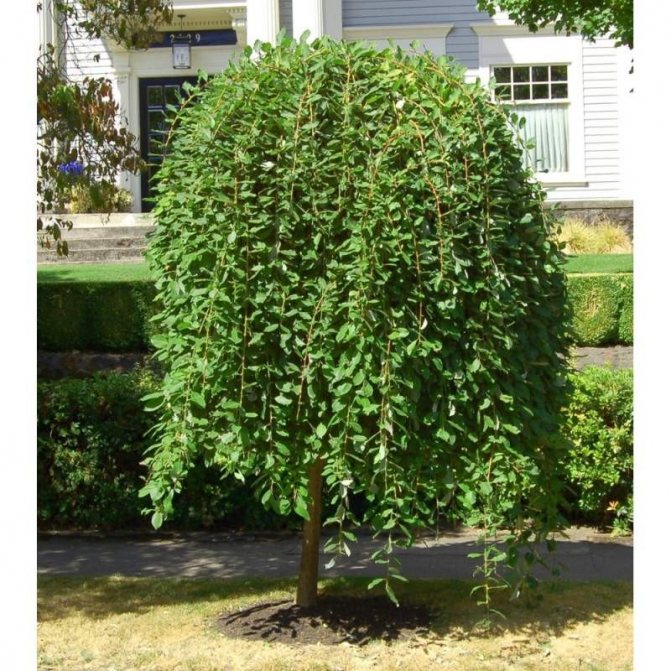

Goat willow globular does not like strong drafts and the shady side. The upper part of the root system reacts sharply to a lack of moisture - to prevent such an incident, use drainage when planting. Also, for the planting pit, fertilization in the form of humus, compost or peat will not be superfluous - this will significantly accelerate the growth of the future tree.
The main field of application of goat willow is parks, squares, reservoirs. It is not uncommon to find hedges made from such plants, and they look very good, especially when combined with other vegetation.
Characteristic
A mature tree turns out to be relatively small - up to six meters. The roots are branched in all directions, which gives additional advantages on stony ground.
The main advantage of willow is its appearance, regardless of the season. In the spring, the so-called seals appear, then foliage appears, which gets an unusual color by winter.
Separately, it should be said about the shoots - here they have a flexible, rod-like shape and reach the soil. With a sufficient level of sunlight, a lush crown forms on the tree, which will only add aesthetics to the plant.
What is a tree
Goat willow belongs to the ornamental varieties. The tree reaches 10 meters in height... The bark of an adult plant has a reddish tint, so the tree is also called a red vine. Young trees have greenish bark. This plant has other names, its name is goat willow, and delirium, and broom.


Goat willow
The crown is distinguished by its magnificent, graceful appearance. Leaves are rounded, pubescent on the seamy side. The tree blooms in April with large fluffy earringswhich have a yellowish silvery color. Men's earrings are oval, while women's earrings are cylindrical. In addition, women's earrings are smaller than men's. The plant belongs to early flowering trees.
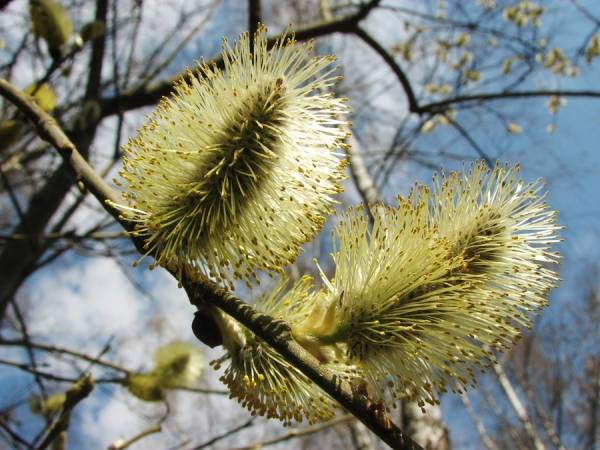

Goat willow color
It is used for landscaping, for medical purposes, baskets and furniture are also woven from it. It will look very effective as a hedge on the trunk. The tree grows quickly, after two to three years you can form a crown and use the plant to decorate the site. The most active growth occurs in the first years of life.
Medicinal use
Willow is a medicinal plant whose leaves, catkins and bark are used to treat various diseases.
Its leaves contain the following beneficial substances:
- vitamins;
- essential oil;
- organic acids;
- lipids and catechins.
A decoction is prepared from the inflorescences of the plant, which has a wound healing, antipyretic and soothing effect.
Medicines made from willow have the following therapeutic effects:
- eliminate inflammatory processes;
- stop bleeding;
- heal wounds;
- fight worms.
Willow is a part of medicines for whooping cough, tuberculosis, gout, rheumatism. Earring decoctions treat arrhythmias and tachycardia. The bark is used to treat colds and gallbladder diseases. Baths are made from it that help against fungal diseases. However, willow medications are contraindicated for persons suffering from gastritis.Pregnant women and children should also be careful when using willow preparations. There are no contraindications for external use.



